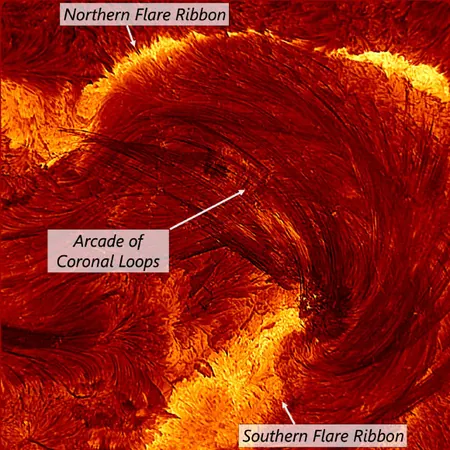
Astronomers Unveil Stunning Details of Solar Flares with Groundbreaking Telescope
2025-08-25
Author: Li
Astronomers Capture Unprecedented Solar Loops
In a groundbreaking discovery, astronomers using the Visible Broadband Imager at NSF’s Daniel K. Inouye Solar Telescope observed coronal flare loops with an astonishing level of detail during the decay of an intense X1.3-class solar flare on August 8, 2024. These loops, which averaged 48.2 km in width and were as narrow as 21 km, are the most minuscule coronal loops ever documented.
What Are Coronal Loops?
Coronal loops are intricate strands of plasma that trace the magnetic field lines of the Sun, often appearing just before powerful solar flares that release tremendous energy. Such flares can trigger solar storms, presenting potential risks to Earth's infrastructure.
A Major Milestone in Solar Research
Dr. Cole Tamburri from the University of Colorado Boulder expressed excitement, stating, "This is the first time the Inouye Solar Telescope has ever observed an X-class flare. These colossal flares are among the most energetic events our Sun can produce, and we were fortunate to capture this one in optimal conditions." The team set its sights on the delicate magnetic loops that loom above the flare.
Unmatched Precision in Observations
With the Inouye Telescope's Visible Broadband Imager tuned to the H-alpha wavelength, astronomers achieved a resolution capable of detecting features as small as 24 km—over two and a half times sharper than its closest rival. Dr. Maria Kazachenko remarked on the thrill of witnessing the telescope perform at such a high level, noting how this discovery opens a new chapter in solar studies.
An Unexpected Discovery
Initially, the researchers planned to analyze chromospheric spectral dynamics but were delighted to uncover ultra-fine coronal structures instead. This unexpected find could significantly enhance flare models that rely on complex simulations, pushing the boundaries of our understanding.
Peering into the Elusive Scale of Solar Dynamics
For years, theories proposed that coronal loops varied from 10 to 100 km in width, but confirming these dimensions has been elusive—until now. Dr. Tamburri asserted, "We’re finally investigating the scales we’ve speculated about for years. This breakthrough allows us to study not just the loops' size, but their shapes, evolution, and the magnetic reconnections that drive flares."
The Essence of Solar Architecture?
This new insight raises tantalizing possibilities: these loops may represent fundamental building blocks of solar flare structures. "If that’s the case, we’re seeing individual loops for the first time instead of just collections of them," said Dr. Tamburri, likening the experience to viewing a forest where one can finally distinguish each unique tree.
Breathtaking Imagery and a Landmark Moment
The resulting imagery is nothing short of mesmerizing, showcasing dark, threadlike loops adorned in brilliant arcs, with sharp contrasts defining the flare ribbons. Dr. Tamburri emphasized, "Even a casual observer would instantly grasp the complexity. It’s a landmark moment in solar science—we’re finally observing the Sun at the scales it operates on."
Research Published in Astrophysical Journal Letters
The findings have been detailed in the Astrophysical Journal Letters, marking a significant advance in our understanding of solar activity.



 Brasil (PT)
Brasil (PT)
 Canada (EN)
Canada (EN)
 Chile (ES)
Chile (ES)
 Česko (CS)
Česko (CS)
 대한민국 (KO)
대한민국 (KO)
 España (ES)
España (ES)
 France (FR)
France (FR)
 Hong Kong (EN)
Hong Kong (EN)
 Italia (IT)
Italia (IT)
 日本 (JA)
日本 (JA)
 Magyarország (HU)
Magyarország (HU)
 Norge (NO)
Norge (NO)
 Polska (PL)
Polska (PL)
 Schweiz (DE)
Schweiz (DE)
 Singapore (EN)
Singapore (EN)
 Sverige (SV)
Sverige (SV)
 Suomi (FI)
Suomi (FI)
 Türkiye (TR)
Türkiye (TR)
 الإمارات العربية المتحدة (AR)
الإمارات العربية المتحدة (AR)